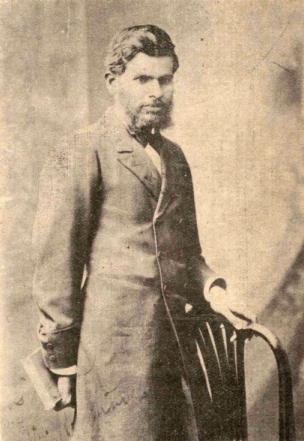Related Research Articles
Varṇa, in the context of Hinduism, refers to a social class within a hierarchical traditional Hindu society. The ideology is epitomized in texts like Manusmriti, which describes and ranks four varnas, and prescribes their occupations, requirements and duties, or Dharma.

Chamar is a Dalit community classified as a Scheduled Caste under modern India's system of affirmative action. They are found throughout the Indian subcontinent, mainly in the northern states of India and in Pakistan and Nepal.
Jatav , also known as Jatava/Jatan/ Jatua/Jhusia /Jataau/Jatiya, is an Indian community that are considered to be a subcaste of the Chamar caste, who are classified as a Scheduled Caste under modern India's system of positive discrimination.Jatavs mostly live in the states of Uttar Pradesh, Madhya Pradesh, Rajasthan, and boundaries of Haryana as well as the Union Territory of Delhi in northwest India.

Vitthal Ramji Shinde was a social and religious reformer in Maharashtra, India. He was prominent among the liberal thinkers and reformists in India, prior to its independence. He has been recognised as a social reformer and an activist fighting for greater equality in Indian society. He is particularly noted for opposing the practice of 'untouchability', and for championing support and education for 'untouchables', such as Dalits.

The Pasi is a Dalit (untouchable) community of India. Pasi refers to tapping toddy, a traditional occupation of the Pasi community. The Pasi are divided into Gujjar, Kaithwas, and Boria. They are classified as an Other Backward Class in Andhra Pradesh and Telangana. They live in the northern Indian states of Bihar and Uttar Pradesh.
Pampady John Joseph (Pampady, 23 May 1887 – 14 July 1940) was a Dalit activist and the founder of the socio-religious movement Cheramar MahajanSabha.
Ramnarayan Rawat is an Associate Professor of History at the University of Delaware and a historian of the Indian subcontinent and has also had appointments at the University of Pennsylvania and University of Washington. He received his B.A. and Ph.D. from the University of Delhi. He has conducted research on the Chamar caste in India, and displayed that their work centred on agriculture and not tanning as previously thought. His work was banned in parts of India for some time due to usage of the word "Chamar." He is the author of the book Reconsidering Untouchability: Chamars and Dalit History in North India and has co-edited the volume Dalit Studies with K. Satyanarayana. He is currently working on his second book entitled Parallel Publics: A History of Indian Democracy.
The Kisan Sabha was a protest movement in the present-day Indian state of Uttar Pradesh that took place between 1919 and 1922. It involved numerous agricultural caste groups. The Uttar Pradesh Kisan Sabha was formed in year 1918 in Lucknow by Gauri Shankar Mishra, Indra Narayan Dwivedi and Madan Mohan Malviya.
Laxman Shrawan Bhatkar was a politician and social worker from Central Provinces and Berar of British India. He was born in 1901 at Thugaon village of then Amravati district of the Province. He studied at Depressed Classes Mission High School at Bombay.

Annai Meenambal Sivaraj was the first Scheduled Caste women president of the South India Scheduled Castes Federation (SCF). She presided over the SCF Women's Conference held at Madras, in 1944, which was attended by B. R. Ambedkar. She also presided over the All India SCF Women's Conference held at Bombay, on 6 May 1945.
Swami Achhootanand, also known as Achutanand or Hariharanand, was a 20th century Indian anti-caste intellectual, Dalit writer, and social reformer. A former Arya Samajist, he became disillusioned with the Arya Samaj and established the Adi Hindu movement. He was a poet, critic, dramatist, and historian.
Chaudhary Chand Ram (1923–2015) was an Indian politician and first Deputy Chief Minister of Haryana.
The Kuril, Kureel are members of Chamar caste and mainly populated in the Central doab and Lower doab regions of the state.They are predominantly members of the Scheduled Castes in Uttar Pradesh.
Seth Kishan Dass was a leather trader, propagator of the Ad-Dharm movement, and a politician.
Khemchand Bohare was a Dalit activist and social reformer.
Ramnarayan Yadavendu (1909–1951) was a Hindi writer, storyteller, essayist and social reformer.
Muldas Vaishya was an Indian politician, activist and social reformer.
Choudhari Mulkiram or Mulkiram Choudhary (1910–1954) was a Hindi poet, philosopher and civil servant.
Pyare Lal Kureel 'Talib' was an Indian politician, Urdu poet and Dalit activist.
Mohini Mohan Das (1886–1949) was an Indian politician, writer and activist from West Bengal.
References
- ↑ Pai, Sudha (30 August 2002). Dalit Assertion and the Unfinished Democratic Revolution: The Bahujan Samaj Party in Uttar Pradesh. SAGE Publications India. ISBN 978-81-321-1991-3.
- ↑ Singer, Milton B.; Cohn, Bernard S. (1970). Structure and Change in Indian Society. Transaction Publishers. ISBN 978-0-202-36933-4.
- ↑ Jaffrelot, Christophe (2003). India's Silent Revolution: The Rise of the Lower Castes in North India. Hurst. ISBN 978-1-85065-670-8.
- ↑ Rawat, Ramnarayan S. (2011). Reconsidering untouchability : Chamars and Dalit history in North India. Bloomington: Indiana University Press. ISBN 978-0-253-35558-4. OCLC 526083948.
- ↑ Rawat, Ramnarayan S. (2011). Reconsidering Untouchability: Chamars and Dalit History in North India. Indiana University Press. ISBN 978-0-253-22262-6.
- ↑ Rawat, Ramnarayan S. (2011). Reconsidering Untouchability: Chamars and Dalit History in North India. Indiana University Press. ISBN 978-0-253-22262-6.
- ↑ Paswan, Sanjay; Jaideva, Pramanshi (2002). Encyclopaedia of Dalits in India: Leaders. Gyan Publishing House. ISBN 978-81-7835-033-2.
- ↑ Kshīrasāgara, Rāmacandra (1994). Dalit Movement in India and Its Leaders, 1857-1956. M.D. Publications Pvt. Ltd. ISBN 978-81-85880-43-3.
- ↑ Ahuja, Amit (26 July 2019). Mobilizing the Marginalized: Ethnic Parties Without Ethnic Movements. Oxford University Press. ISBN 978-0-19-091642-8.
- ↑ "Members Bioprofile". loksabhaph.nic.in. Retrieved 7 June 2020.
- ↑ Kshīrasāgara, Rāmacandra (1994). Dalit Movement in India and Its Leaders, 1857-1956. M.D. Publications Pvt. Ltd. ISBN 978-81-85880-43-3.